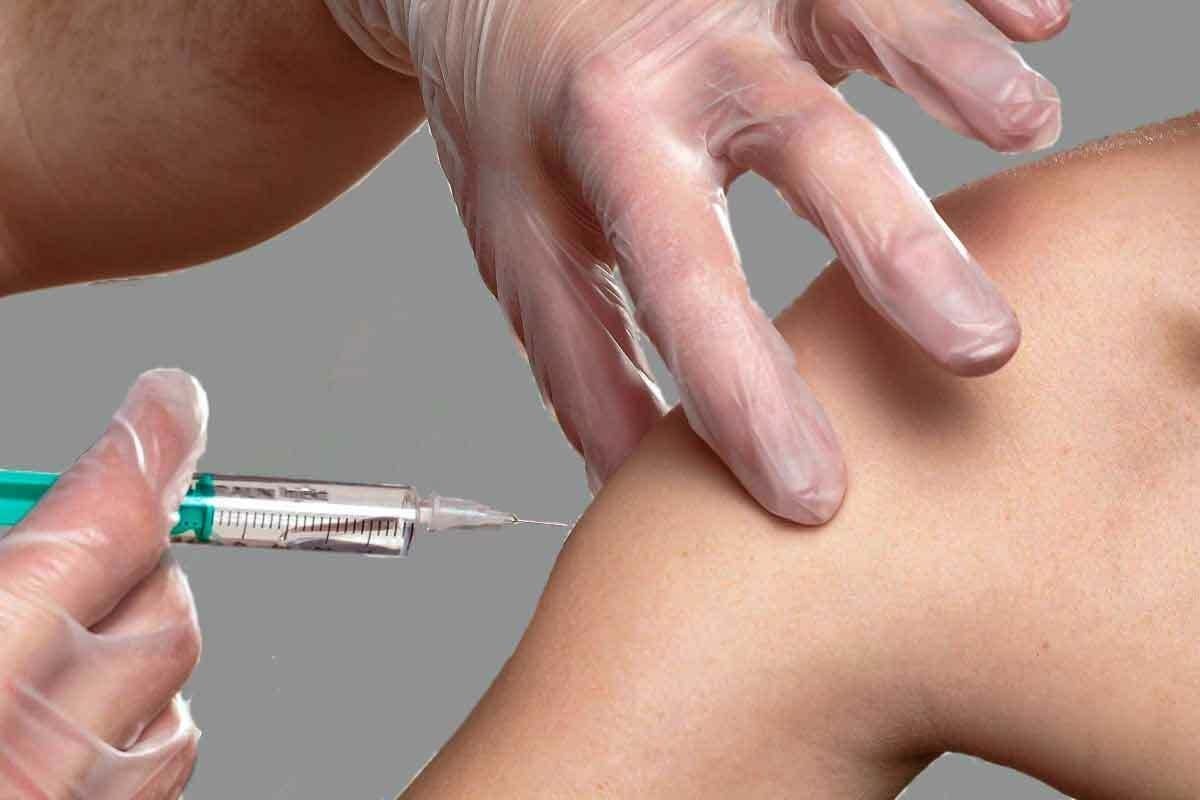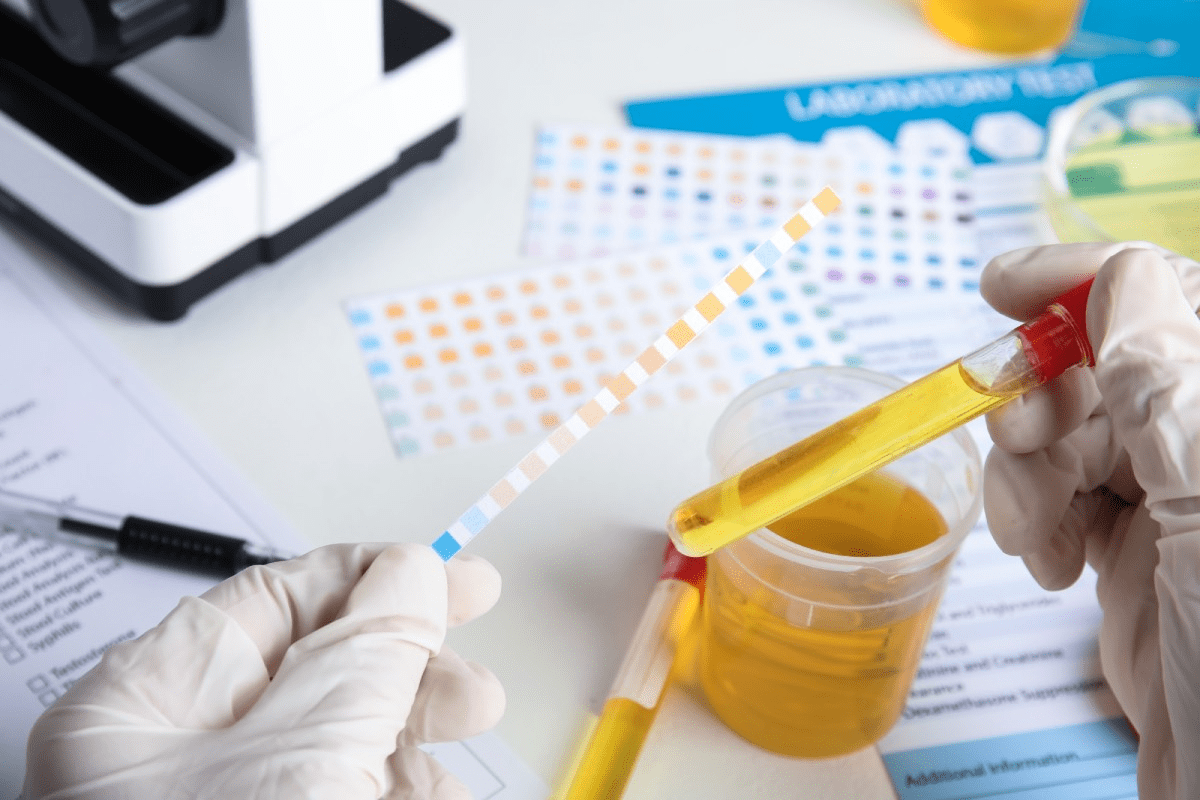Last Updated on November 26, 2025 by Bilal Hasdemir
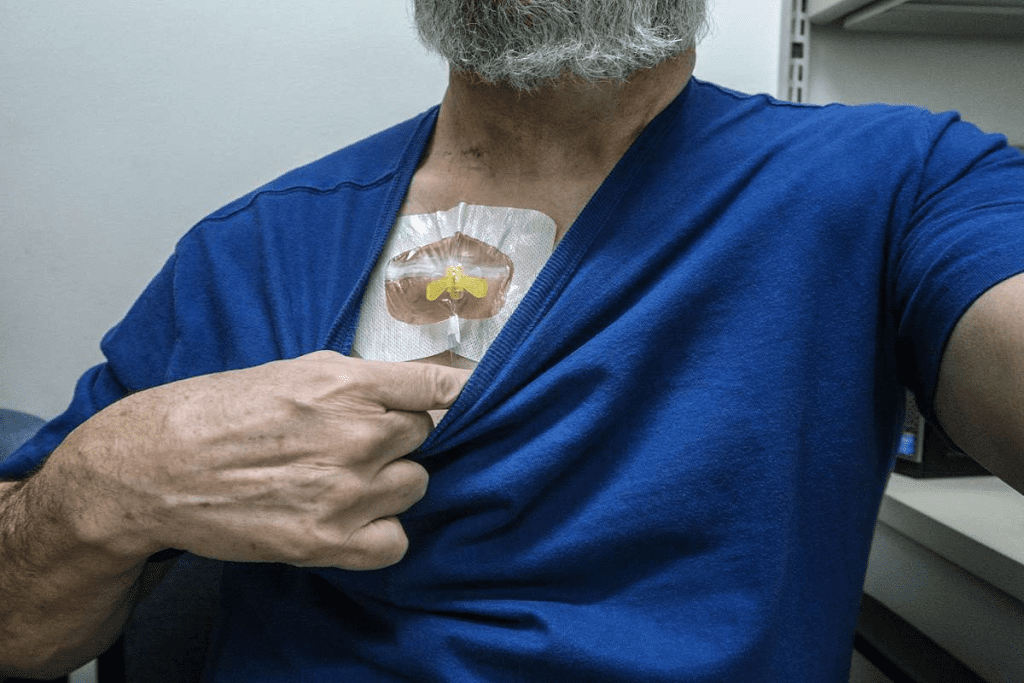
For those going through chemotherapy, getting a chemo port is a key step. Every year, over 1.2 million people in the U.S. are diagnosed with cancer, and many will receive chemotherapy as part of their treatment. A chemo port is a small device implanted under the skin ” typically in the chest area ” to safely deliver chemotherapy and other medications. Understanding where chemo port goes is important, as it is placed in a vein to allow direct access for treatment. Getting a chemo port is a minor surgery performed under local anesthesia.
Key Takeaways
- The chemo port is implanted under the skin, typically in the upper chest area.
- The procedure is relatively minor and is performed under local anesthesia.
What is a Chemo Port?
A chemo port is a small, implantable device for chemotherapy and other treatments. It’s a type of port catheter. It makes it safe and easy for doctors to give medicines directly into the blood.
Key Components of a Chemo Port:
- A small reservoir, known as the port, which is implanted under the skin.
- A catheter that connects the port to a vein, typically in the chest or arm.
Doctors use a special needle to access the chemo port. This way, they can give treatments without needing to stick needles in the vein often. This is great for patients on long-term chemotherapy or other treatments.
The American Cancer Society says, “Chemo ports make treatment easier. They cut down on the need for frequent needle sticks.” This is a big plus for those on long treatments.
To sum up, a chemo port is a helpful device. It makes giving chemotherapy and other treatments easier. This improves comfort and treatment results for patients.
Benefits of Chemo Ports
Chemo ports offer a big advantage over traditional IV lines. They reduce discomfort and risks during chemotherapy. These ports provide a safe and stable way to get chemotherapy drugs.
- Reduced risk of infection due to fewer needle sticks
- Less discomfort during chemotherapy administration
- Convenience for patients and healthcare providers
- Reduced risk of extravasation
| Benefit | Description |
| Reduced Infection Risk | Fewer needle sticks reduce the risk of infection |
| Less Discomfort | Minimizes the pain associated with frequent injections |
| Convenience | Eases the administration of chemotherapy |
How Chemo Ports Work
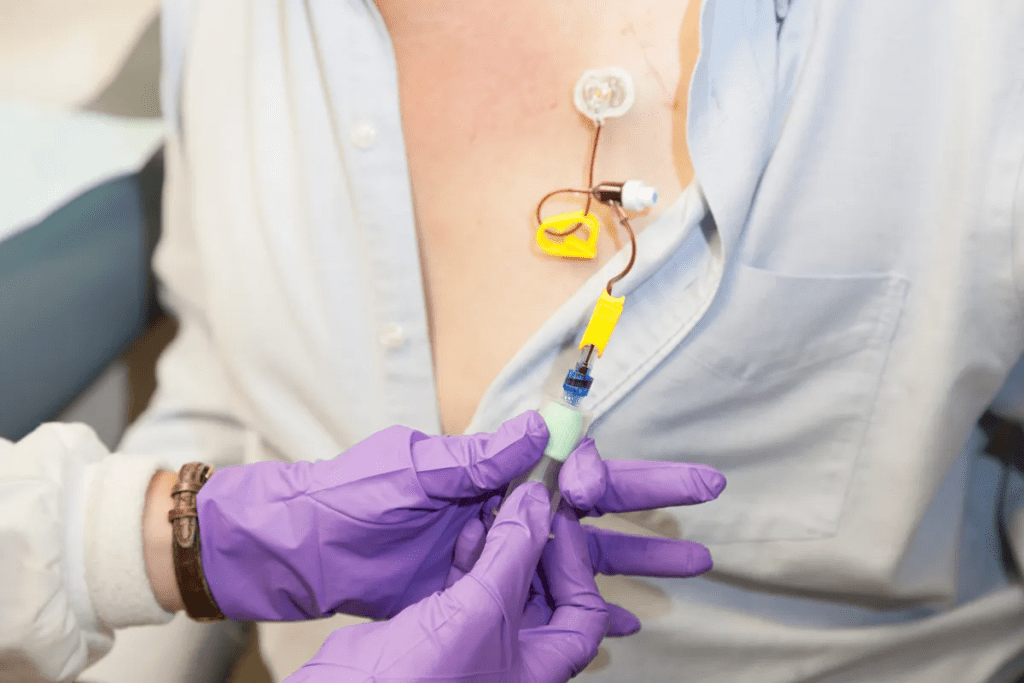
A chemo port is a device that helps put chemotherapy and other treatments into your blood. It’s a small, implantable device placed under the skin in the chest.
The chemo port has two main parts: the reservoir and the catheter. The reservoir holds the medication. The catheter is a thin tube that connects the reservoir to a vein. This design allows for safe and efficient delivery of chemotherapy, reducing the need for repeated needle sticks and minimizing complications.
When it’s time for treatment, a healthcare professional accesses the port. They insert a needle through the skin and into the reservoir. The medication is then given through the catheter into the bloodstream. This process is quick and can be done in a clinical setting.
“The use of chemo ports has revolutionized the way chemotherapy is administered, providing patients with a more comfortable and convenient treatment option.”
After treatment, the port is flushed with a saline solution. This keeps it clear and ready for future use. Keeping the port maintained is key to its longevity and preventing complications.
- The port is accessed with a needle for treatment administration.
- The catheter delivers the medication directly into the bloodstream.
- Regular flushing maintains the port’s functionality.
Overall, chemo ports are a vital tool in cancer treatment. They offer a reliable and efficient way to deliver chemotherapy and other medications. Their design and functionality have greatly improved the treatment experience for many patients.
Living with a Chemo Port
Having a chemo port can change your daily life, but it’s manageable with the right care. Patients with a chemo port need to know a few important things for a smooth experience.
Keeping the port clean and avoiding infections is a big concern. This means keeping the area dry after implantation and following strict hygiene during dressing changes. Watch for signs of infection like redness, swelling, or increased pain around the port site.
Adjusting to life with a chemo port requires some changes. You might need to avoid heavy lifting or contact sports to prevent damage. But, most people can keep up with their usual activities after the healing period.
To manage your port well, you should:
- Watch the port site for signs of infection or complications
- Follow your healthcare provider’s advice for flushing and maintaining the port
- Go to all scheduled follow-up appointments
By taking care of your chemo port and making a few adjustments, you can lessen its impact on your daily life. This way, you can focus more on your treatment and recovery.
Potential Complications
Chemo ports, like any invasive medical device, come with risks. They are generally safe but knowing the possible issues is key for those getting chemotherapy.
Common Complications
- Infection: There’s a chance of infection with chemo ports, just like with any invasive device.
- Blood Clots: The port can sometimes cause blood clots to form.
- Device Malfunction: Though rare, the device might not work right and need extra medical help.
Table: Possible Complications and How to Handle Them
| Complication | Description | Management |
| Infection | Bacterial infection around the port site | Antibiotics, possible removal of the port |
| Blood Clots | Clot formation due to the port | Anticoagulant therapy |
| Device Malfunction | Failure of the port to function correctly | Replacement of the port |
It’s vital for patients to know about these possible issues and talk to their healthcare provider. Regular checks and good care of the chemo port can lower the risk of these problems.
Understanding the possible complications and how to handle them helps patients manage their chemotherapy with a chemo port better.
Removing a Chemo Port
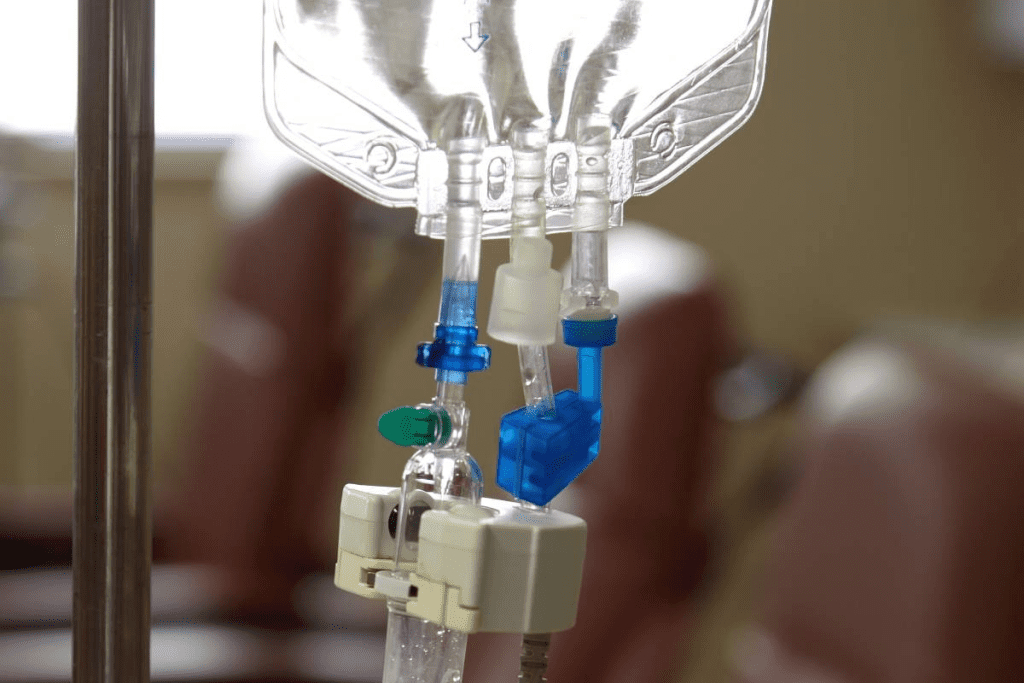
Removing a chemo port is a simple surgery done after chemo is finished. It’s usually done without needing to stay overnight in the hospital.
To remove the port, a small cut is made in the skin. Then, the port is carefully taken out from the tissue around it. The tube connected to the port is also removed. The cut is then closed with stitches or staples.
Key Steps in Chemo Port Removal:
- The patient is given local anesthesia to numb the area around the port.
- A small incision is made to access the port.
- The port and catheter are carefully removed.
- The incision is closed, and the area is bandaged.
After the surgery, patients are watched for a bit before going home. Some soreness or bruising is normal. But, it usually goes away in a few days.
Removing a chemo port is a big step in fighting cancer. It shows the treatment is almost over. But, more care is needed after that.
It’s very important for patients to follow their doctor’s advice after the port is removed. This helps the healing process and avoids any problems.
Role of Chemo Ports in Cancer Treatment
Chemo ports are key in cancer treatment, making it easier to get chemotherapy into the blood. This method helps manage cancer well, making treatment smoother for patients.
They are great for those on long-term chemotherapy. Chemo ports offer a safe spot for treatment, cutting down on the need for many needle sticks. This means less pain and fewer risks than traditional IV lines.
Key Advantages of Chemo Ports in Cancer Treatment:
- Reliable access for chemotherapy administration
- Reduced risk of medication leakage or extravasation
- Minimized discomfort and pain for patients
- Lower risk of infection compared to traditional IV lines
- Enhanced patient comfort and quality of life during treatment
Chemo ports make chemotherapy delivery more efficient. Doctors can give treatments faster and more accurately. This is very important in fighting cancer.
Also, chemo ports help make cancer care more personal. Treatment plans can be made just for each patient. This considers the cancer type, stage, and the patient’s health.
In summary, chemo ports are essential in cancer treatment today. They offer a safe, effective, and kind way to give chemotherapy. As cancer care keeps getting better, chemo ports will likely stay very important.
Comparison with Traditional IV Lines
Traditional IV lines have long been the norm for giving chemotherapy. But, chemo ports are becoming more popular because of their many advantages. Unlike traditional IV lines, chemo ports don’t need repeated needle insertions, which can be painful.
Key differences between chemo ports and traditional IV lines include:
- Reduced risk of infection with proper care
- Less discomfort during chemotherapy sessions
- Greater flexibility for patients, allowing for easier movement
- Fewer complications related to needle insertion
Even though traditional IV lines are common, chemo ports are a good choice for many. The choice between them depends on what the patient needs and wants, and their cancer treatment plan.
In short, chemo ports have many benefits over traditional IV lines. They are more comfortable, safer, and offer more freedom. As cancer treatment keeps improving, chemo ports will likely be used more often.
Chemo Port Maintenance
Keeping a chemo port safe and working well is key. Regular care is essential to avoid problems and keep the port working right during treatment.
Key aspects of chemo port maintenance include regular flushing, dressing changes, and watching for signs of infection or other issues.
- Regular flushing with saline or heparin solution to prevent clotting
- Dressing changes to maintain sterility and prevent infection
- Monitoring for signs of infection, such as redness, swelling, or fever
Patients need to know how to take care of their chemo port and spot problems early. This means:
- Keeping the port site clean and dry
- Avoiding heavy lifting or bending that may cause discomfort or displacement
- Reporting any unusual symptoms or signs of infection promptly
Healthcare providers are key in teaching patients about chemo port care. They should give clear instructions and be ready to answer any questions or concerns.
By sticking to a strict care routine, patients can lower the risk of chemo port problems. This makes the cancer treatment process smoother.
Frequently Asked Questions
Understanding chemo ports can be easier by answering common questions.
Many people, including patients and their families, have questions about chemo ports. They want to know about their use, benefits, and possible complications. Here are some questions that can help explain the role of chemo ports in cancer treatment.
Q: What is a chemo port?
A chemo port is a small device implanted under the skin. It helps deliver chemotherapy and other medications directly into the bloodstream.
Q: How is a chemo port implanted?
Getting a chemo port is a minor surgery done under local anesthesia. The device is placed under the skin, usually in the chest area.
Q: What are the benefits of using a chemo port?
Chemo ports have many benefits. They reduce the risk of infection compared to traditional IV lines. They also cause less discomfort during chemotherapy sessions. Plus, they make it easier to avoid repeatedly accessing a vein.
It’s usually advised to avoid getting the chemo port wet until it heals after implantation. Once it’s healed, patients can usually shower and do other activities without too many restrictions.
Q: How is a chemo port removed?
Removing a chemo port is another minor surgery. It’s done when the patient has finished their chemotherapy or no longer needs the device.
These FAQs cover the main points about chemo ports, from how they’re implanted and used to how they’re maintained and removed. If you have more questions or concerns, it’s best to talk to your healthcare provider.
Advances in Chemo Port Technology
New chemo port technology is changing cancer treatment. It offers patients better and less painful options. These changes are key to making chemotherapy easier.
Chemo ports have gotten a lot better. They are now made from materials that work well with the body. This lowers the chance of problems. For example, antimicrobial coatings help fight off infections, a big worry with old ports.
Now, there are low-profile ports that are less visible under the skin. This makes patients feel more comfortable and confident. These ports also make it easier for doctors to give treatments, making the process smoother.
Technology has also made ports easier to put in and take out. This makes the surgery safer and the treatment more bearable for patients.
Research is ongoing to make chemo ports even better. Scientists are looking at new materials and designs. They want to make ports that are more durable and work better for patients.
As technology keeps improving, we can expect even more exciting advancements. Maybe we’ll see smart ports that can check their own status. Or ports made just for certain patient needs.
Conclusion
Chemo ports have changed cancer treatment for the better. They make it safer and more efficient to get chemotherapy and other meds. Knowing how chemo ports work helps patients choose the best treatment.
Chemo ports are better than old IV lines in many ways. They lower the chance of infection and make patients more comfortable. With the right care, chemo ports can be a key part of cancer treatment.
New tech in chemo ports makes them even safer and more effective. As cancer treatment keeps getting better, chemo ports will likely stay important. Keeping up with new chemo port tech helps patients and doctors get the best results.
FAQ
Where is a chemo port typically placed?
A chemo port is usually placed under the skin in the chest area, just below the collarbone. The exact location may vary depending on individual anatomy and the doctor’s preference.
What is the procedure for chemo port placement?
Chemo port placement is a minor surgical procedure. It involves making a small incision in the skin and inserting the port under the skin. The catheter is then guided into a large vein, typically through a vein in the neck or chest.
How long does a chemo port last?
A chemo port can remain in place for several months to a few years. This depends on the individual’s treatment plan and needs. It can be removed when it’s no longer needed.
Can I shower or bathe with a chemo port?
Yes, you can shower or bathe with a chemo port. But avoid submerging the port in water until the incision site is fully healed.
How is a chemo port accessed for chemotherapy?
A chemo port is accessed using a special needle. This needle is inserted through the skin and into the port. This allows healthcare professionals to administer chemotherapy, blood draws, or other medications directly into the port.
What are the possible complications of a chemo port?
Possible complications of a chemo port include infection, blood clots, and catheter malfunction. Regular maintenance and monitoring can help minimize these risks.
How is a chemo port maintained?
Chemo port maintenance involves flushing the port with saline solution or heparin. This prevents blood clots and keeps the catheter clear. This is typically done by a healthcare professional during chemotherapy sessions or at regular intervals.
Can I travel with a chemo port?
Yes, you can travel with a chemo port. But it’s essential to discuss your travel plans with your healthcare team. Take necessary precautions, such as carrying a letter explaining your medical condition and the presence of the chemo port.
Is a chemo port painful?
The chemo port placement procedure is typically done under local anesthesia. So, you won’t feel pain during the procedure. Some people may experience discomfort or soreness at the incision site after the procedure. But this usually resolves quickly.
How is a chemo port removed?
Chemo port removal is a minor surgical procedure. It involves making a small incision in the skin and removing the port and catheter. The procedure is usually done under local anesthesia.
References
- National Cancer Institute (NCI). (2023). Central Venous Catheters. https://www.cancer.gov/about-cancer/treatment/types/chemotherapy



